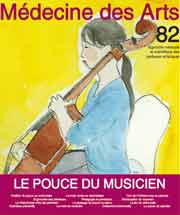Revue Médecine des arts N°82

Revue Médecine des arts N°82Artist'Health, musicians, singers, dancers, painters
Number 82 on the health of the singer, musician, and dancer
Medical and scientific approach to artistic practices
French Journal
Free shipping
Edito Arts Médecine N° 82
The Musician's Thumb
AbstractThe author describes the functional anatomy of the thumb and its opposition mechanism, which brings the joints, ligaments, and muscles into play. The role of the thumb in musical instrument playing is explained, with emphasis on its physiological functioning.
Michel Boutan
Key words: hand; thumb; musician; opposition mechanism; functional anatomy; joint; ligament; muscle.
Rethinking the Thumb Position on the Cello: Ergonomic and Pedagogical Considerations
AbstractLearning to shift into thumb position on the cello is a critical stage, and students often have trouble achieving balance in their playing in this new position where the thumb becomes an active finger in the upper registers. In order to analyze this problem, the author, a cellist herself, conducted a survey among conservatory-of-music students (observations of beginning and advanced classes, questionnaires) and teachers (interviews). The difficulties experienced by students of all levels appeared to be the result of a lack of body awareness while playing the instrument, along with a poor understanding of the biomechanics of the movement required to shift the hand from the neck to the fingerboard. Furthermore, students often fail to organize their practicing schedule, even those who are pursuing a professional career.
Based on these findings, the author proposes some physical and cognitive exercises for cello students and some suggestions for cello teachers.
Elisabete Costa
Key words: musician; hand; upper limb; cello; thumb position; training; pedagogy; ergonomics; proprioception.
The Clarinet Player's Right Hand: Solutions to Thumb Problems
AbstractIn clarinet playing, the right hand must both support the instrument with the thumb and correctly position the longer fingers for playing. This dual task requires keeping the hand in the proper position. Many clarinet players find this very difficult, due notably to the inconvenient location of the thumb rest on the instrument. The location of the thumb rest was determined during a period of history when the clarinet was light and the playing posture was different, and it has never been truly challenged since. On today's instruments, then, the thumb rest's position should be reconsidered to allow the right hand to function in a more physiological manner. The author discusses the physiology of the clarinet player's right hand, while explaining the common problems encountered by players, and proposing some possible solutions for improving their ease-of-play during musical performances, including posture and movement exercises and adaptation of the instrument and accessories.
Matthieu Belmont
Key words: musician; clarinet player; clarinet; hand; thumb; thumb rest; accessories; posture; movement; prevention.
Rhizarthrosis and Piano Playing
AbstractRhizarthrosis is a degenerative disease of the trapeziometacarpal joint. Clinical knowledge provides insight into the impact of this condition on a pianist's playing during crossing-over. This thumb position, which is specific to piano playing, is analyzed by the authors at the functional and rehabilitation levels.
Michel Boutan, Gaétan Stierlen
Key words: musician; pianist; piano; hand; thumb; pathology; rehabilitation.
Impact of Wearing an Orthesis for Pianists with Rhizarthrosis
AbstractTo look into the impact of wearing an orthesis or orthopedic brace among pianists with rhizarthrosis, three pianists were assessed. The pianists were tested initially without an orthesis, then with three different types of orthesis, and then again after 45 days of wearing the chosen orthesis. The results pointed out an improvement in the pressure exerted on the piano keys and in the muscular activity of the thumb, along with a decrease in pain during playing. An orthesis fitted to the patient, accompanied by follow-up by a specialist, should allow rhizarthrosic pianists to continue playing or start playing again.
Gaétan Stierlen
Key words: musician; pianist; piano; hand; thumb; rhizarthrosis; pain; orthesis.
Version papier
17€
Subscription, France, EEC (1 year, 2 issues)
34€
Subscription Outside EEC (1 year, 2 issues)
37€
Les garanties médecine des arts
Articles en stock
Envoi dans les 24h
Paiement
en ligne sécurisé
Une question ?
